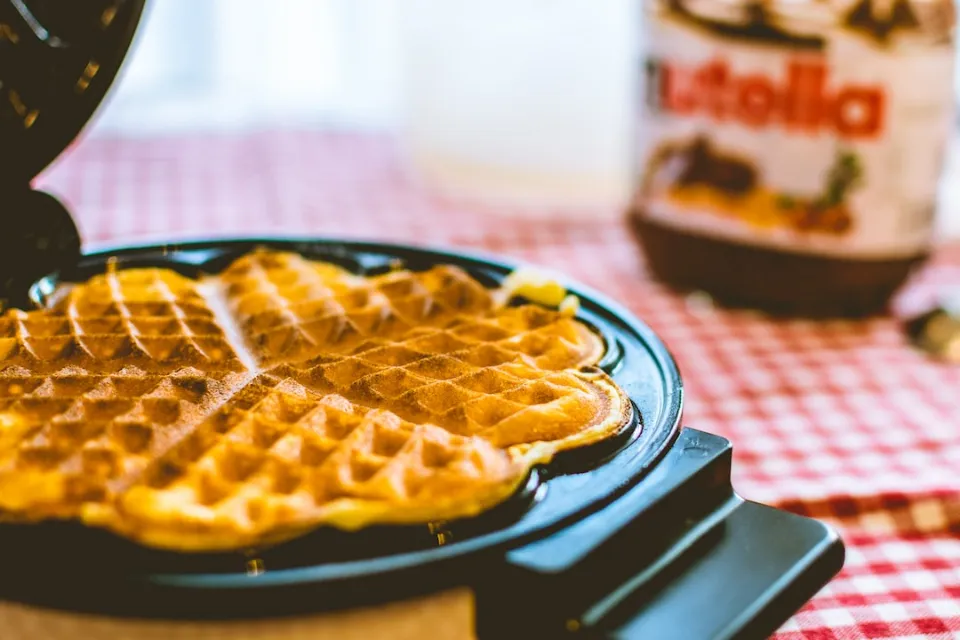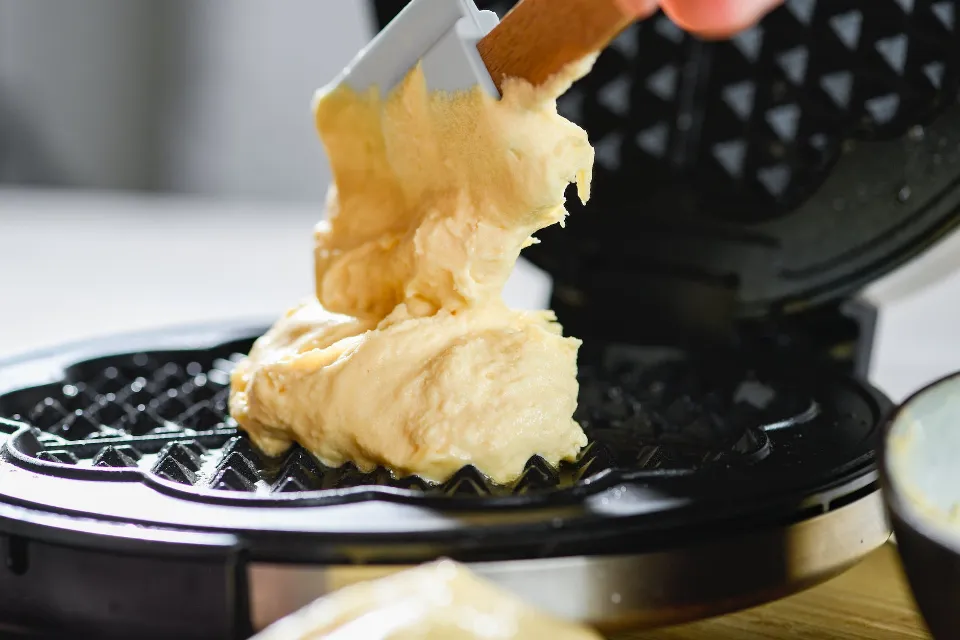Waffles are a welcome breakfast treat on a Sunday morning, but what’s not welcome is the task of cleaning the gunked-up waffle maker. It can be frustrating because the grid’s numerous nooks and crannies make excellent batter traps.
Waffles aren’t dead yet, so hold on. If you have a few tricks up your sleeve, cleanup doesn’t have to be a pain. Take note of these recommendations before making another waffle.

Table of Contents
Do You Need to Clean a Waffle Iron?
Your kitchen appliances need to be kept clean. Your kitchen’s appliances, including your waffle maker or iron, need to be kept clean just like the rest of the room.
After using it to make your preferred breakfast or treat, your waffle maker needs to be thoroughly cleaned. Your waffle maker may not only look unappealing if you leave wet batter drips and other residues on it, but doing so may also promote the development of bacteria and molds.
Therefore, regular waffle iron cleaning is essential to avoiding the microbial buildup that shortens the appliance’s lifespan.
What to Look for in An Easy-to-Clean Waffle Maker
The following characteristics help with cleaning.
- Nonstick cooking plates: They aid in preventing the batter from sticking.
- Removable grid plates: Cleaning is simpler because of them, and some are dishwasher-safe.
- Drip tray: They stop batter spills from ruining the waffle maker’s sides and your kitchen counter.
- Smooth exterior: The fewer crevices there are, the less space there is for runaway batter to ooze into.
- Batter cup: They let you measure out a precise amount of batter for the waffle maker, to avoid overflow in the first place.
How to Clean Your Waffle Maker
Even if your waffle maker aces CR’s ease-of-use test, grease, batter, and crumbs are unavoidable when making waffles. Following are some cleaning instructions for your appliance and some pointers for preventing spills before you begin cooking.
Make your countertop battery-proof. Put a piece of parchment or aluminum foil underneath the waffle maker before you start cooking to catch batter crumbs. Simply throw away the dirty sheet when you are finished.
Maintain the nonstick finish. Any object that is sharp or abrasive runs the risk of scratching the nonstick coating on your waffle maker, which will cause a sticky spot. Skip the metal utensils and instead use a wooden chopstick to get underneath a waffle to lift it out when it’s done cooking.
Avoid using nonstick aerosol sprays and over-greasing. Preparing the grids with a greased paper towel before use is advised by the instructions in the majority of waffle maker manuals. After that, you shouldn’t need to oil the plates again as you cook; too much grease will end up oozing out beyond the grid and potentially into crevices, or worse, the controls. Chemicals in nonstick cooking sprays cause the nonstick coating to burn onto the plates.
Before cleaning, allow the waffle maker to cool slightly. Although it should not be hot, cleaning is easier when the appliance is still warm. The plates should be cleaned both inside and out by using a damp paper towel and a clean pastry brush to remove crumbs.
Waffle maker needs a steam cleaning. After you’ve finished cooking, unplug the waffle maker and stack some damp (not dripping wet!) paper towels on the bottom plate and close the lid. While you eat, leave it sitting so that the residual heat will help all the grime transfer to the paper towels and prevent crusting.
Clean tough stains with a spotter. If there is any lingering crud in the wells, scrub it out with a Q-tip dipped in soapy water while the waffle maker is still warm. Use a toothpick to scrape out any batter that may have become lodged in the waffle maker’s controls, exterior, or small crevices.
Wipe down fixed parts. If you are unable to remove the grid plates, clean them with a damp paper towel; avoid soaking any waffle maker parts.
Know your capacity. Take the time to check your waffle maker’s capacity and measure out the precise amount of batter each time if you frequently find yourself cleaning up a large waffle mess. In addition, you might need to increase the amount of fat in the batter if waffles frequently stick.

5 Tips for Waffle Maker Maintenance
A good waffle maker that you know and trust is a great tool in the kitchen. You can maintain its functionality and brand-new appearance by following a few simple guidelines.
1. If you need cleaning advice specific to your waffle maker, always consult your user guide or the manufacturer’s website.
2. Waffle makers that are nonstick should only require a thin layer of cooking oil before use (not before each waffle is made). Cooking oil is best applied with a pastry brush or in a refillable spray bottle like a Misto. Cooking sprays in an aerosol can leave a sticky residue on nonstick surfaces.
3. Never submerge an electric waffle maker in water.
4. Avoid using metal or sharp objects to remove cooked waffles or to scrape off caked-on batter. This might just be the beginning of future issues with stuck waffles.
5. If your waffles do start to stick, check to see if you’re using enough oil to grease the grid. Your batter’s butter content will also be crucial. Less problems with stuck waffles result from using more butter in your recipe.
Conclusion
Those sticky residues can be avoided by doing a quick cleanup after each waffle-making session. In order to continue making the ideal fluffy or crispy waffles for years to come, you’ll also make sure you’re maximizing the useful service life of your waffle maker.
Your health may benefit from a thorough cleaning of your waffle maker after each use. Cleaning your appliance will assist in limiting the spread of bacteria.
Don’t leave your waffle maker horribly sticky and covered in batter drips before putting it away. Give it a good wipe, both inside and out, and you won’t be faced with lots of waffle-making residues that’s difficult to clean off.
FAQs
How Do You Clean a Non Removable Plate in a Waffle Maker?
To soften tough residue, you might also try wiping the waffle maker with a hot towel. Making a paste out of baking soda and water is another well-known waffle maker cleaning tip. Apply it to the waffle maker’s grid surface, let it sit for a few hours, and then wipe it off with a damp cloth.
Can You Clean a Waffle Maker With Vinegar?
What is this? You can also use vinegar-soaked q-tips on any leftover grease you find on the inside of your waffle maker. Give it one last wipe with a dry paper towel once you’re finished with the interior.
Why Do Waffles Stick to the Waffle Iron?
Either too little or too much oil. Batter may stick if there is no egg yolk in it; must have egg yolk or oil for non-stick. Spraying the plates with a non-stick product is always advised. This lowers the likelihood of sticking.
How Do Hotels Clean Waffle Makers?
Get a tool with a pointed end, like a pencil or chopstick, and wrap a small piece of paper towel around it to clean the oil that builds up in the waffle iron’s grid. Use it to clean the residue and oil that accumulates within the grid after moistening it with white vinegar.





